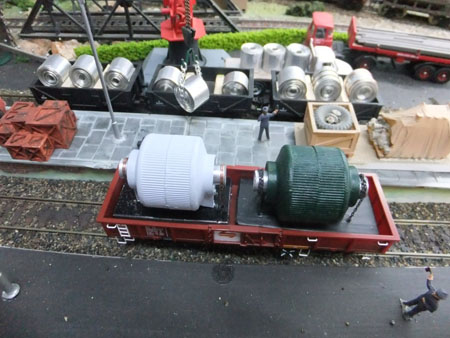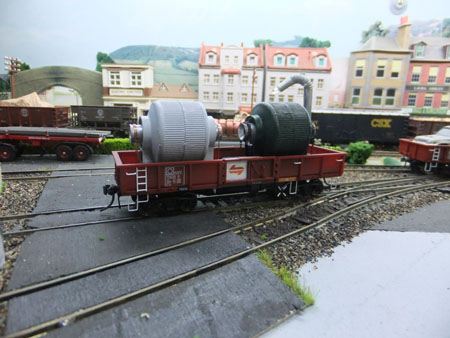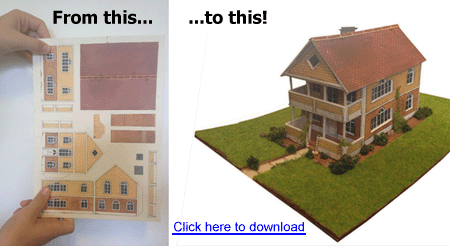“Something I have done that did not turn out so cheap ( because of the size of that layout) was using insulation spray foam to mold and shape mountains etc.
I then covered it with plaster cloth (using a spray water bottle).
Poking with sticks and fingers to take to the shape of the spray foam was an amazing realistic look and time saver, however next time I will semi preform the mountains with chicken wire to save costs.
Dave”
“I like using black drywall sandpaper for roofing. It looks good and easier to cut than plastic roof slate.
Michael”
“I would like to add to Dave’s comments:
1) Start small & simple. Plan your work and work your plan. Just because you have 100 sq feet does not mean you have to fill it ALL immediately. It is easy to get overwhelmed by too large a project.
2) Break your schedule down into smaller “achievable” projects. The sense of accomplishment on each project will encourage you to move on. You can always expand your layout as time & resources permit.
3) Get at least 1 locomotive & some rolling stock operational. It serves as to break to just to watch something moving (see #5).
4) If in doubt: a) seek help; b) experiment –> be patient, not everything works every time, even on a real railroad!!
5) Most important: RELAX!! HAVE FUN!! ENJOY IT!! Model railroading is a hobby – not your life’s work.
Cheers
Peter”
“Don’t know how much help this is… but
1) Don’t be afraid to make mistakes
2) Don’t be afraid to change scales!
I went from ”N” gauge to a 1:20.3 garden Rail Road. THAT has been a lot of pleasure! I can finally see what I’m working on.
I still have the small loop of track outside, but it’s not much fun freezing my “Jingle Bells” off in the winter but great fun for my grandson and I when the weather is nice.
Having been bitten by the “Narrow Gauge” Bug AND the “Geared Locomotive” I am now working in On30… and plan on following my own suggestions.
Been thinking about a Shelf Layout, but don’t know if that will satisfy me… now that the kids are out of the house I just might take-over their bedrooms. LOL
Don’t know if this helps…. But it has been my experience as time went by. When I started in “N” Gauge there was no way I could have afforded a Bachmann 2-Truck Shay for an outdoor layout.
Sometimes… our wants and capabilities change over time… as long as we STAY in the best hobby in the world… no worries.
Thank you!
Jeff ”
“I have used plastic straws for lamp posts, and I used them to put the wires through the track base for street or any other lights for the houses, etc. We use rynolite instead of plaster mould for scenery, i.e. mountains.
Kind regards,
Noel ”
“Alastair after getting your email some time ago on tips sent in by Roger on Model train flat bed loads I decided to give it a go.
I have included a couple of photos on my finished product on which I think have turned out rather well.
The only problem is that the liquid last for some time and it takes time to gather enough to make some more.
Hope you like the photos and look forward to receiving more of your email tips.
Kind regards
Dennis”
The flat bed ‘how to’ was sent in by Roger, and it’s here. It’s also reminded me, I have another of Roger’s which I haven’t published yet.
Latest ebay cheat sheet is here. Have a peek!
Best
Al





Thanks for all the tips. I hope Peter won’t mind if I use his comments at our upcoming show. Hopefully, they will encourage others to get into this wonderful hobby!
VERY GOOD
Nice great looking loads
I really enjoy your site especially the o gauge layouts. Would you have any info on making bumpers for lionel o gauge track?
Thanks,
Tom
You may want to substitute screen such as used in screened porches for chicken wire. Because of its small openings it works much better for moulding and plastering.
Truly enjoy seeing all the tips, all the different layouts from a variety of you. If any of you have 0-27 layouts, ideas, videos please send them to me.
i like what i see with those paste or glue houses
I see Rhinolite as a gypsum product for finishing but not as Noel stated when spelled rynolite. Was this just a misspelled word? Does it set faster and is it easier to use? Thanks interested in possibly using.
Need more scenery suggestions and how too. Also how to do running water scene
Flatbed loads and dio are terrific!!! Well done
I watched a video that used the plastic bubble off carded products as flat car loads here in US. After finding the bubble you like and it fits your flat car cover it with toilet tissue, spray it lightly with diluted white glue, leave wrinkles that will occur, looks like tarpaulin folds. Let it dry and apply more glue mixture, drying in between coats. It looks like a tarped lost, cost almost nothing.
“leave wrinkles that will occur, looks like tarpaulin folds.”
Would you post a link or a picture, please?
I learned a great technique for building mountains from Marklin of Sweden. I found him on U tube. He uses Aluminum screen wire, toilet paper, and white glue. Briefly, the screen wire is cut in handful size pieces crumpled and combined in the desired shape, covered with toilet paper dipped in a thin glue bath, applied over the screen wire, and allowed to dry. It’s quite hard and can be reshaped somewhat. I highly recommend checking out his website.
MY last post was about building mountains. However I am getting too old to do fine work (Arthritis and failing eyesight) so I have completely gone over to using Woodland Scenic’s Shaper sheet. It’s the best method I have seen.
excellent
LOL, that was my plan, but before I got it started, my daughter moved back home n filled the space with her junk 😭
Noel, besides using straws to make lamp posts, etc, I have used the plastic tubes used on cotton ear buds after they have been used. Cut the ‘cotton wool’ off each end and you are left with a pipe approximately 3 mm diameter which can be used to make a long length of ‘pipeline’ by joining these lengths of the cotton ear bud ‘pipe’ using a short length of toothpick pushed into one end of the pipe this is then pushed into the other end of another ‘pipe’ until you get the length of pipeline that you want. Another use is to use it to make a wire in a tube sort of affair, the joins between each section can be some sort of glue to hold them together.